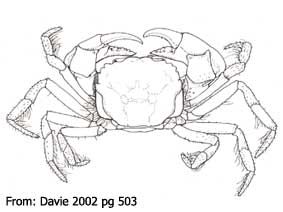Descriptive Features: carapace rounded, sometimes poorly calcified, anterolateral margin cristate, entire or toothed, front with or without shallow median indentation, without latero-external notch
eyes relatively small
antennules folded completely into fosset, antenna lying in orbital hiatus
buccal frame quadrangular
3rd maxillipeds wide, almost completely closing buccal cavity
exopod broad, with flagellum
thoracic sternum very broad, with all sutures interrupted
large part of sternite 8 exposed, supplementary transverse suture in middle of sternite 8, parallel to suture 7/8, forming supplementary plate
sterno-abdominal cavity deep
male abdomen with segments 3-5 fused
abdominal locking mechanism in normal position
vulvae of female very large, occupying position near extremity of sternal suture 5/6
male penis very long, lying in covered channel on sternite 8, only uncovered next to the coxa of last leg, finally protruding as long soft papilla
chelipeds with minor heterochely and heterodonty
male 1st gonopod stout, moderately tapered, with an apical aperture, 2nd gonopod about as long as 1st, with flagellum about same length as peduncle
Carapace width: |

|
Australocarcinus riparius |
|